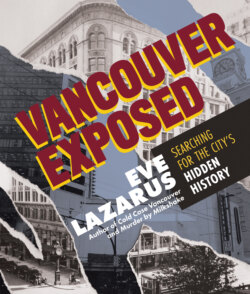Читать книгу Vancouver Exposed - Eve Lazarus - Страница 6
На сайте Литреса книга снята с продажи.
ОглавлениеINTRODUCTION
I started my blog Every Place Has a Story in 2010 as a way to add to stories from my first book, At Home with History: The Untold Secrets of Greater Vancouver’s Heritage Homes. The blog quickly became my obsession, and I looked forward to digging into a new story every week. When people asked me what my blog was about, I told them it was about history and heritage houses and murder. But that really meant anything I thought was interesting—from street photographers to ghosts, research tips to legendary women, and others who are typically not found on the front page of newspapers.
Later I started the Every Place Has a Story Facebook page and soon I was connecting with bloggers, tour guides, artists, academics and amateur historians who shared a love for Vancouver’s quirks and the city’s often seedy history. Gradually people started to post comments and personal anecdotes from their own family histories, and little by little the stories took on new life. These observations and memories, as well as photos scanned from family albums, then helped shape the direction of this book.
Early in 2019, I mentioned to Arsenal Pulp publisher Brian Lam that my blog was approaching its tenth anniversary, and I was thinking of self-publishing a book of my stories. Brian said Arsenal might be interested and asked me to send him a proposal. I did, and I am thrilled that this is the result.
Vancouver Exposed is not meant to be read from start to finish. It jumps from walled-up sculptures to missing murals to repurposed buildings. There are crashes, explosions, scary institutions and crimes. There are amazing athletes, squatters, architects and a sea captain. There are stories of big plans that never happened, missing theatres, a fake house and not-so-secret tunnels.
The book is divided into six areas, starting with what’s always been one of the city’s most important intersections, Granville and West Georgia.
There are still regal old buildings dotting the area around that intersection, and over the years, I’ve been in and out of several of them—the Hudson’s Bay department store, the Vancouver Art Gallery, the Hotel Vancouver and the Hotel Georgia. I may have even noticed the three nurses looking down from their eleventh-storey parapets on the Georgia Medical-Dental Building, but it wasn’t until the early part of this century that I gave any thought to these buildings, or what was there before them. Much later, when I fell in love with Vancouver’s sleazy underbelly and dwindling heritage, I found that our civic enthusiasm for pulling things down has always been with us. In fact, it’s astounding when you think in terms of not what we’ve lost but what we’ve struggled to retain.
The section about the Downtown Eastside includes stories that explore how Hastings Street evolved from the “Great White Way” to our current mess. It looks at Woodward’s department store’s forgotten elevator operators, Christmas window displays and $1.49 Day, and travels through tunnels, stations and terminals.
In the West End section we have the much-loved English Bay lifeguard and swimming teacher Joe Fortes, successful salon and beauty school owner Maxine MacGilvray, the English Bay Pier, the Hippocampus fish and chip shop and the distinctive Stuart Building. The neighbourhood is still home to the century-old Polar Bear Swim, a long-forgotten cemetery and several of Vancouver’s buried houses.
In the section of the book that encompasses the city west of Main Street, there are ghost signs on buildings to remind us of businesses past, and there are the houses of Downtown South, that mostly exist only in memory. There is an exotic museum that is now a record store, a former bootlegging joint turned restaurant and a sheet-metal rocket ship.
In the section about what lies east of Main Street there’s Chuck Currie’s red-and-white polka-dotted house, an infant memorial garden, an axe murder, the annual summer spectacle of the Pacific National Exhibition and the Japanese internment camps at Hastings Park.
The North Vancouver section features a murder in a convent and a monument to remember the atrocities of the residential school system. Just across Burrard Inlet from downtown Vancouver, Canada’s oldest nudist camp, an annual belly flop competition and an inn that has served as a resort, a brothel and an illegal gambling establishment are all fair game.
Got your own story about Vancouver’s hidden history, or something to add? Post a comment on my blog, or get in touch at info@evelazarus.com. I’d love to hear from you!
